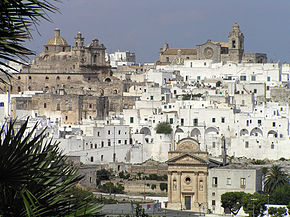Salento
| Salento | |
 View of the city of Ostuni |
|
| Geographical location | |
| Coordinates | 40 ° 20 ′ N , 18 ° 0 ′ E |
| Waters 1 | the Adrian Sea |
| Waters 2 | Gulf of Taranto |
| length | 100 km |
| width | 40 km |
Salento is the name of a 100 km long and 40 km wide peninsula in the extreme southeast of Italy and is often referred to as the heel of the Italian boot .
Administratively, the peninsula belongs to the Apulia region and includes the province of Lecce and parts of the provinces of Taranto and Brindisi . Older names for the peninsula are Iapygia , Messapia , Calabria, and Sallentina . The southernmost point of Salento is the Punta Ristola .
The most important cities on Salento are Lecce , Brindisi and Otranto .
history
Cave finds ( Grotta Zinzulusa ) have been made from prehistoric times and dolmens and menhirs have been preserved as remnants of early peasant culture. In ancient times, the area was inhabited by the Messapi , an Illyrian tribe who had to defend their independence in wars against the Greek settlement of Taras ( Taranto ). Herodotus reports a war around the year 474 BC. Between Taras and the Lega Peuceta (an alliance from the area around Bari ), which was supported by the Lega Messapica (from Salento). In this conflict, the Messapians were able to keep the upper hand after several years of war, from around 280 BC. However, the Roman Republic gained dominance in all of southern Italy (see Tarentine War ).
Between the ninth and tenth centuries, Salento was often attacked by the Saracens . In 927, the Muslims occupied the city of Taranto, which was rebuilt just forty years later by the Byzantine Emperor Nikephorus II . After the conquest by the Normans, the county of Lecce was founded and in 1088 the principality of Taranto. Lecce in particular, the birthplace of the Norman King Tankred , developed into the capital of the Salento peninsula during the Middle Ages, which was then also known as " Terra d'Otranto ".
Some witnesses of that time are the fortress Castello Aragonese in Otranto , the castle in Acaya and numerous Staufer castles. The defense tower Torre Moro in Galatone , which belonged to the fortified farm “Masseria Vasce”, and the small chapel of San Pietro in Vicolo are also well preserved.
language
The Italian dialect spoken in Salento is completely different from the dialects spoken in the rest of Puglia. Rather, it resembles the Sicilian idiom with its open vowels .
There are also some Greek linguistic islands , which were probably created by a medieval migration (see also Griko ). The Greeks settled mainly in the Salentine city triangle Gallipoli, Nardò, Otranto (all Greek names). Around 1500 the Greek community consisted of 24 communities; by the end of the 18th century it shrank to 15. Today there are only eight villages in the old Graecia salentina in which the Griko is present in today's dialect: Sternatia, Martignano, Calimera, Corigliano, Zollino, Martano, Castrignano and Soleto.
architecture
Salento also differs from the rest of Apulia in terms of architecture. The traditional houses are built according to the Greek style, ie they are whitewashed and have a flat roof. The historical city centers, on the other hand, are mainly built in the Lecce Baroque style, with typical Salento details such as the exuberant façade painting of palazzi and churches. The most popular building material was the pietra leccese , a rock with a warm reddish-yellow color.
In the rest of Apulia, the typical historical architectural style, in contrast to Salento, is predominantly Spanish Baroque or Romanesque .
literature
- Angelo Massafra: Campagne e territorio nel Mezzogiorno fra Settecento e Ottocento. Edizioni Dedalo, 1984, ISBN 9788822060396 , p. 289 ff.
Individual evidence
- ↑ Tips and sights for a visit to Galatone. Retrieved June 6, 2018 .
- ^ Gerhard Rohlfs : Vocabolario dei dialetti salentini (Terra d'Otranto). Publishing house of the Bavarian Academy of Sciences, 1956.
- ↑ Alicia Morales Ortiz: The teaching of modern Greek in Europe. Current situation and new perspectives. Editum, 2010, ISBN 9788483719381 , p. 132 ff.
